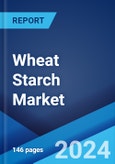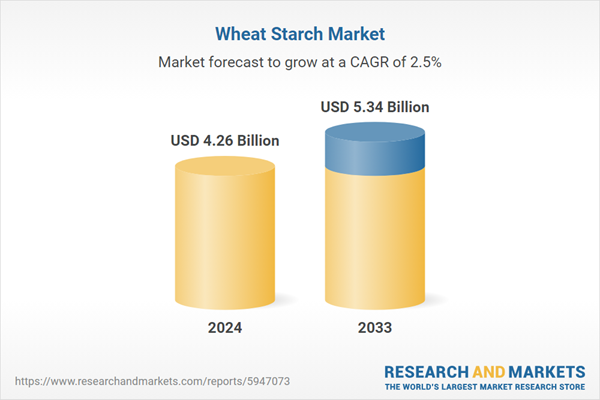Wheat starch is a white, fine powder derived from wheat grains. It is a common ingredient used in various food and industrial applications. It can be obtained by separating the gluten and bran from wheat flour, which leaves behind the pure starch. It is known for its neutral taste and high digestibility, which makes it suitable for individuals with gluten sensitivity. It is a crucial component in products, such as bakery items, noodles, and sauces, wherein it enhances texture and consistency. It is utilized in the production of biodegradable plastics, adhesives, and papermaking due to its adhesive properties and ability to form a film.
Wheat starch is widely used as a thickener, stabilizer, and gelling agent in the food and beverage (F&B) industry for manufacturing various food products, such as sauces, soups, gravies, dressings, desserts, bakery goods, and confectionery items. This, coupled with the increasing preferences among individuals for ready to eat (RTE) food products on account of busy schedules, rising working population, and expanding purchasing power of consumers, is strengthening the growth of the market around the world. Moreover, the increasing use of wheat starch in the pharmaceutical industry as a filler and binder in tablet formulations, which enables the production of cohesive and uniform tablets, is favoring the growth of the market. In addition, wheat starch is employed in the textile industry in sizing processes to enhance the strength and quality of yarn and fabrics. This, along with the rising consumer preferences for natural and organic products, is contributing to the market growth. Apart from this, the growing adoption of wheat starch in the manufacturing of cosmetic and personal care products, such as skincare formulations, to provide texturizing and emollient properties is influencing the market positively.
Wheat Starch Market Trends/Drivers
Increase in health consciousness among the masses
With an increasing focus on the consumption of healthy and natural ingredients, wheat starch offers a gluten-free alternative to traditional starch sources. Consumers with gluten sensitivities or celiac disease seek gluten-free options, and wheat starch caters to this demand. As awareness of gluten-related health issues rises, the demand for wheat starch as a safe and reliable gluten-free substitute is increasing.Rise in demand for clean label products
Consumers today are increasingly seeking products with simple and transparent ingredient lists. Wheat starch, being a natural and minimally processed ingredient, aligns with this clean label trend. Its recognizable and straightforward sourcing appeals to health-conscious consumers who prioritize products free from artificial additives and chemicals. As demand for clean label products continues to surge, the demand for wheat starch as a clean and wholesome ingredient is likely to grow.Growing number of trade and export activities
The global market for wheat starch is significantly influenced by international trade and export opportunities. Wheat-producing countries with surplus starch production capacity actively engage in exporting wheat starch to meet the demand of other regions. Cross-border trade allows for the distribution of wheat starch to countries where it may not be locally produced, expanding its reach and driving demand in diverse markets. Trade agreements and globalization further facilitate the accessibility of wheat starch in different regions, stimulating the market growth.Wheat Starch Industry Segmentation
This report provides an analysis of the key trends in each segment of the global wheat starch market report, along with forecasts for the period from 2025-2033. The report has categorized the market based on end-use.Breakup by End-Use
- Sweeteners
- Fuel
- Paper and Textile
- Food
- Others
The report has provided a detailed breakup and analysis of the market based on the end-use. This includes sweeteners, fuel, paper and textile, food, and others. According to the report, sweeteners represented the largest segment. Wheat starch can be enzymatically converted into glucose syrups or modified to produce wheat-based sweeteners. These sweeteners find applications in various food products, beverages, and confectionery items as alternatives to traditional sugars. They offer different levels of sweetness and functionalities, making them valuable ingredients in the food industry.
Wheat starch can be utilized in the production of bioethanol, a renewable fuel source. The starch is broken down into sugars and then converted into ethanol through a fermentation process. Bioethanol serves as a sustainable and environmentally friendly alternative to fossil fuels, which contributes to efforts to reduce greenhouse gas emissions and dependence on non-renewable resources.
Wheat starch is used in the papermaking industry as a binder and sizing agent to improve paper strength and surface properties. It enhances the ability of the paper to retain ink and improves printability. Additionally, in the textile industry, wheat starch can be employed as a sizing agent to give fabrics a smoother and more consistent finish during weaving.
Wheat starch plays a crucial role in the food industry as a thickener, stabilizer, and texturizer. It is commonly used in baked goods, sauces, soups, and desserts to enhance texture and improve overall product quality. Wheat starch is also found in noodles, pasta, and other processed foods, where it provides structure and stability during cooking. It is preferred for its neutral taste and gluten content, making it suitable for various food applications.
Competitive Landscape
The leading companies are focusing on using enzyme technology that can lead to more efficient and specific enzymatic processes to extract wheat starch. This can result in higher yields, reduced energy consumption, and improved overall process sustainability. They are also implementing advanced automation and control systems that can enhance the accuracy and efficiency of wheat starch processing, which ensures consistent product quality and reduces human error. Moreover, key players are extensively investing in research and development (R&D) activities to explore genetic engineering or biotechnological approaches to improve wheat varieties with higher starch content or altered starch properties to suit specific industrial applications. They are also adopting the usage of nanotechnology that can be applied to modify wheat starch at the molecular level, which creates unique functionalities and improves its performance in various applications, such as in the paper, textile, or food industries. Besides this, leading players are leveraging data analytics and digital technologies to optimize wheat starch production processes, which leads to increased productivity, cost-effectiveness, and improved resource management.The report has provided a comprehensive analysis of the competitive landscape in the market. Detailed profiles of all major companies have also been provided. Some of the key players in the market include:
- Tate and Lyle
- Roquette Freres
- Cargill Inc.
- Archer Daniels Midland
- Tereos Syral
- Crespel & Deiters
- Jackering
- Kroner Starke
Key Questions Answered in This Report
1. What is the impact of COVID-19 on the global wheat starch market?2. What was the global wheat starch market size in 2024?
3. What are the major global wheat starch market drivers?
4. What are the major trends in the global wheat starch market?
5. What will be the global wheat starch market outlook during the forecast period (2025-2033)?
6. What is the global wheat starch market breakup by end use?
7. What are the major regional markets in the global wheat starch industry?
8. Who are the leading global wheat starch industry players?
Table of Contents
Companies Mentioned
- Tate and Lyle
- Roquette Freres
- Cargill Inc.
- Archer Daniels Midland
- Tereos Syral
- Crespel & Deiters
- Jackering
- Kroner Starke
Methodology

LOADING...
Table Information
| Report Attribute | Details |
|---|---|
| No. of Pages | 133 |
| Published | February 2025 |
| Forecast Period | 2024 - 2033 |
| Estimated Market Value ( USD | $ 4.26 Billion |
| Forecasted Market Value ( USD | $ 5.34 Billion |
| Compound Annual Growth Rate | 2.5% |
| Regions Covered | Global |
| No. of Companies Mentioned | 8 |









